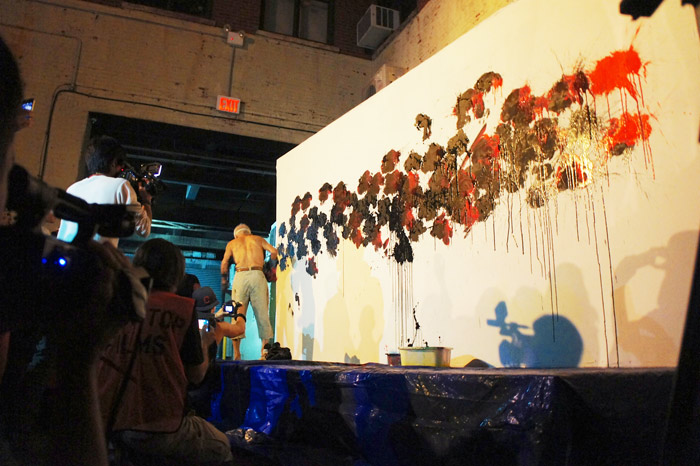The blue hour eased itself into the end of what had turned out to be a beautiful day despite a rainy morning. Adult couples on Saturday night dates showed their IDs at the door of the Old American Can Factory in Gowanus as volunteers gave them wristbands for courtyard or rooftop seating. Some patrons filed into the courtyard as a selection of non-abrasive indie pop songs floated down into the courtyard “cheap seats.” 150 chairs were set up before a large screen on the wall of a factory wing.
Those with rooftop wristbands followed signs through the long halls and winding staircases of the factory, operated and maintained by XØ Projects Inc, before stepping into the open-air theater. Plastic folding chairs offered a decadent escape, thanks to generously spaced rows, no doubt painstakingly placed by a team of hungry volunteers pursuing filmmaking careers.
In its 17th year, Rooftop Films is a non-profit film festival and production collective based in Brooklyn, New York that teaches filmmaking to young people, and rents equipment at low-cost to artists and non-profits. It is also well known for screening a summer-long series of films, rotating through a cache of 20 different venues around New York City.
There was plenty of behind-the-screens effort, as a team managed the synchronized broadcast of the film onto the courtyard screen at the same time it was playing on the roof. The rest of Brooklyn carried on with itself. Planes made their descents, while saxophone music and laughter from a neighborhood gathering somewhere in nearby punctuated the quiet moments.
The last of seats were filled as the music ended and Program Director Dan Nuxoll approached the microphone to introduce the film, Cutie and the Boxer, its director Zach Heinzerling, and subjects Noriko and Ushio Shinohara. “I feel very at home here,” Noriko shared, “where I live opens onto a balcony which is the roof of the next door factory.” She was confident, yet demure, the epitome of a Japanese wife, welcoming the audience into the life that Heinzerling captured on film.
Cutie and the Boxer is a brief chapter of the difficult symbiosis of Noriko and Ushio, two flowers struggling to thrive in a single pot for close to 40 years. Introduced to the artist couple by a journalist friend, Heinzerling approached the Shinoharas in 2008 with cameras and began an obsessive collection of footage. A young cinematographer, Heinzerling was compelled to focus on a relationship that has little time for romance. He saw their meager DUMBO home as a perfect backdrop for the life of a starving artist.
Ushio Shinohara has been making inroads to the art scene since the early 1960s, with cardboard motorcycles and Boxing paintings, which grasp at the fury of Jackson Pollock, if Pollock had tapped into a meditative state, dipped foam-covered boxing gloves in pans of paint and boxed his way across a blank canvas. Early in his career, his colorful irreverence attracted young Noriko, an affluent student who quickly fell into a passionate affair with her countryman.
Right hooks and left jabs trademarking Ushio’s brand of action painting seemed to lack the punch Heinzerling was searching to power the story. He instead relied heavily on art-docs from the 1970s and 80s to help describe the Japanese Neo-Dadaist character.
Reflecting on her past, Noriko uses calligraphy to illustrate the life of the impressionable “Cutie” who came to New York City and fell passionately in love with the volatile “Bullie,” an ineffectual artist who is often sprawled beneath a table, having emptied bottles of wine.
Heinzerling used Noriko’s art to animate the narrative, and the film is able to hint at the sadness that tints the life Noriko and Ushio have shared through the years. The young director exploits the light pouring into the couples home to expose the complicated kind of love that has sustained the creative dependence Ushio and Noriko work to cultivate. When the wind ruffled the outdoor screen, it gave the projection a shimmering quality.
However, Heinzerling tends to dehumanize his subjects, a fact that was exposed by listening to him describe his methodology while seated beside Ushio and Noriko. Ushio apparently felt a bit misled by Heinzerling. The 80-year old artist was under the impression that Heinzerling was composing yet another art-doc, but to Ushio’s dismay, it turned out to be a love story. The lovers are a fascinating example of the breadth in what constitutes a healthy relationship. There is no lack of complexity to the film.
Ultimately, it isn’t hard to forgive the young director. It is clear that he has much to experience, much to learn about love, but Cutie and the Boxer is a worthy effort at attempting to contribute something powerful to the world of art.
By Brette Weinkle
























